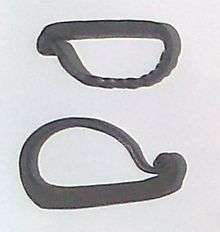Fire striker



A fire striker (or fire steel) is a piece of high carbon or alloyed steel from which sparks are struck by the sharp edge of chert or similar rock.[1] [2][3] Modern fire strikers, commonly called "artificial flints", are made from ferrocerium alloys.
History
In early times, percussion firemaking was often used to start fires. Before the advent of steel, a variety of iron pyrite or marcasite was used with flint and other stones to produce a high-temperature spark that could be used to create fire.[4] There are indications that the "Iceman" called Ötzi may have used iron pyrite to make fire.[5]
From the Iron Age forward, until the invention of the friction match, the use of flint and steel was a common method of firelighting. Percussion fire-starting was prevalent in Europe during ancient times, the Middle Ages and the Viking Age.[3][6]
When flint and steel were used, the fire steel was often kept in a metal tinderbox together with flint and tinder. In Tibet and Mongolia they were instead carried in a leather pouch called a chuckmuck.
In Japan, percussion firemaking was performed, using agate or quartz. It was also used as a ritual to bring good luck or ward off evil.[7][8]
Use
Besides using flint with the steel, many other hard, non-porous rocks can be used, that can take a sharp edge, such as chert, jasper or chalcedony.[2]
The sharp edge of the flint is used to strike the fire steel at an acute angle. With practice, small pieces of steel are shaved off the fire steel. The friction of shaving the steel off the fire steel and the pyrophoricity of the steel heats the pieces to a molten state.
Charcloth or amadou ("tinder fungus") is sometimes used as tinder with flint and steel to catch the low-temperature sparks, which can then can be brought to other tinder and blown into flame. However, many woodsmen of previous centuries had to do without charred cloth or fire fungus and kept charred plant material in their tinderboxes.
See also
- Coat of arms of Serbia (includes pictures of fire strikers)
- Ferrocerium
- Tinderbox
Notes
- ↑ Bush, Darren. "Traditional Firestarting Part I: How to Make Fire with Flint and Steel". Manly Skills, Self-Reliance, Survival. Art of Manliness. Retrieved 27 July 2015.
- 1 2 "Do you have 5 Ways to Make Fire?". Survival Cache. Retrieved 27 July 2015.
- 1 2 "Fire from Steel - Custom forged fire steels from Roman through Fur Trade time periods". Angelfire.com. Retrieved 2013-07-21.
- ↑ http://www.primitiveways.com/marcasite%20and%20flint.html
- ↑ http://www.iceman.it/en/mapleleaves
- ↑ "Viking Answer Lady Webpage - Viking Age Fire-Steels and Strike-A-Lights". Vikinganswerlady.com. Retrieved 2013-07-21.
- ↑ http://alicegordenker.wordpress.com/2010/12/23/do-it-yourself-kiribi/
- ↑ http://www.japantimes.co.jp/news/2010/12/16/reference/kiribi/
External links
| ||||||||||||||||||||||||||||||||||